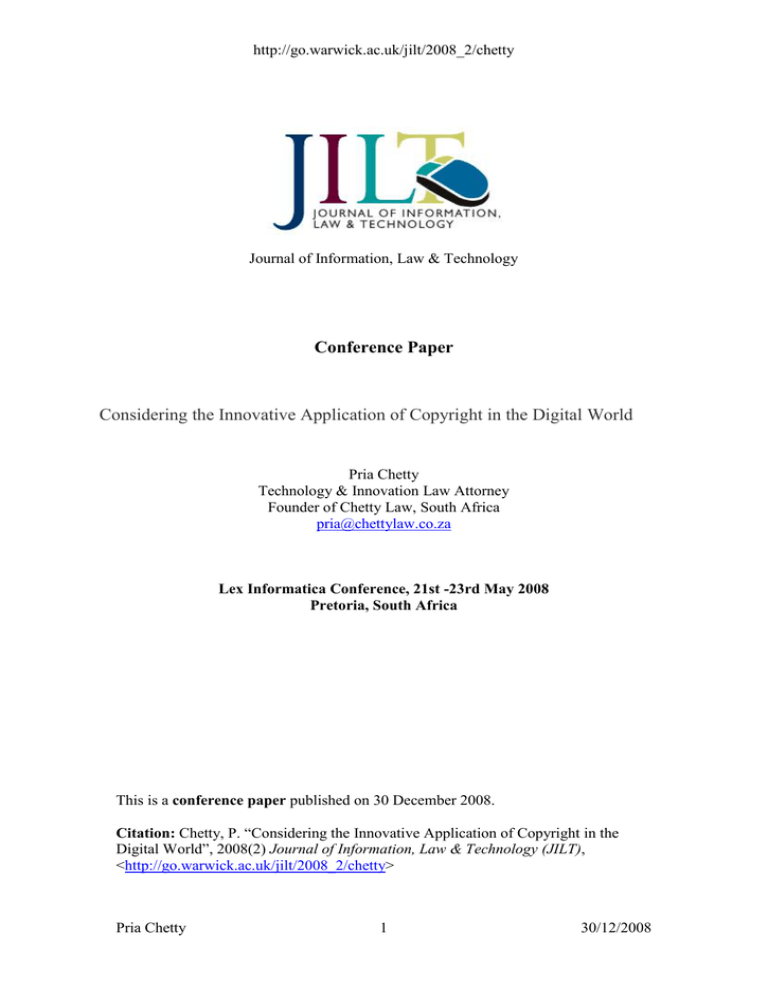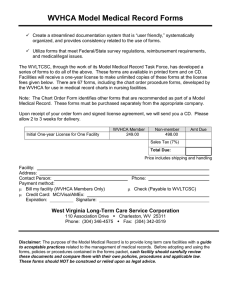
http://go.warwick.ac.uk/jilt/2008_2/chetty
Journal of Information, Law & Technology
Conference Paper
Considering the Innovative Application of Copyright in the Digital World
Pria Chetty
Technology & Innovation Law Attorney
Founder of Chetty Law, South Africa
pria@chettylaw.co.za
Lex Informatica Conference, 21st -23rd May 2008
Pretoria, South Africa
This is a conference paper published on 30 December 2008.
Citation: Chetty, P. ―Considering the Innovative Application of Copyright in the
Digital World‖, 2008(2) Journal of Information, Law & Technology (JILT),
<http://go.warwick.ac.uk/jilt/2008_2/chetty>
Pria Chetty
1
30/12/2008
http://go.warwick.ac.uk/jilt/2008_2/chetty
Abstract
John Perry Barlow in his article ―The Economy of Ideas‖ refers to the problem of digitized
property: ―The enigma is this: If our property can be infinitely reproduced and
instantaneously distributed all over the planet without cost, without our knowledge, without
its even leaving our possession, how can we protect it? How are we going to get paid for
the work we do with our minds? And, if we can't get paid, what will assure the continued
creation and distribution of such work?1‖ This paper questions the application of copyright
as to digitised works protected and whether a more innovative application of copyright is
required in the context of digital works2 and the ―information economy‖.
What is Digitisation?
According to online information technology encyclopedia and learning centre WhatIs.com
<http://whatis.techtarget.com/definition/0,,sid9_gci896692,00.html>:
“Digitization is the process of converting information into a digital format. In this format,
information is organized into discrete units of data (called bits) that can be separately
addressed (usually in multiple-bit groups called bytes). This is the binary data that
computers and many devices with computing capacity (such as digital cameras and digital
hearing aids) can process.”
According to a White Paper ―The Diverse and Exploding Digital Universe‖ produced
by the technology consultancy IDC and sponsored by the IT firm EMC
<http://documents.scribd.com/docs/1mue2bcovd69fdljfi01.pdf>:
+
the digital universe 3 in 2007 — at 2.25 x 1021 bits (281 exabytes or 281 billion
gigabytes) as a result of faster growth in cameras, digital TV shipments, and better
understanding of information replication;
+
by 2011, the digital universe will be 10 times the size it was in 2006; and
Pria Chetty
2
30/12/2008
http://go.warwick.ac.uk/jilt/2008_2/chetty
+
fast-growing corners of the digital universe include those related to digital TV,
surveillance
cameras,
internet
access
in
emerging countries,
sensor-based
applications, datacenters supporting ―cloud computing,‖ and social networks.
For the rights holder of intellectual property over digitised information, a review of the
results of the survey is actively pursued by the question: What if any impact does the
exploding digital universe have on intellectual property frameworks?
Perhaps answering this question 14 years prior to the release of the IDC White Paper, in the
March 1994 issue of Wired Magazine, John Perry Barlow, in his article ―The Economy of
Ideas‖ announced to the world that everything we know about intellectual property is
wrong. Barlow’s article, notwithstanding its revolutionary nature raised questions that
remain pertinent as we consider the complexity of the ever expanding digital universe.
Barlow raised the enigma of digitised property:
―The enigma is this: If our property can be infinitely reproduced and instantaneously
distributed all over the planet without cost, without our knowledge, without its even leaving
our possession, how can we protect it? How are we going to get paid for the work we do
with our minds? And, if we can't get paid, what will assure the continued creation and
distribution of such work?‖
With respect to intellectual property, Barlow observed that digital technology is detaching
information from the physical plane, where property law of all sorts has always found
definition. Barlow’s view was that the current intellectual property law could not be
customised to contain digitised expression. He called for an entirely new set of methods as
befits an entirely new set of circumstances.
In an interview 10 years after the publication of the article with Benjamen Walker (Audio
Berkman producer), Barlow stated that he thought his article was communicating the
obvious.
Pria Chetty
3
30/12/2008
http://go.warwick.ac.uk/jilt/2008_2/chetty
Barlow’s closing remarks surrounded a shift in business strategy to cope with the enigma of
digitised property: a shift towards a service provider relationship or a relationship of
performance versus the product based business strategy.
This shift heralded a new point of view regarding the information economy – a shift in
protectionist intellectual property regimes to collaborative ―open‖ culture brought on by the
internet and digitised information, ―copyleft‖.
Why Copyleft?
A
few
thoughts
from
The
Next
Economy
of
Ideas
<http://www.negativland.com/wired.html>:
―The Grateful Dead, for whom I once wrote songs, learned by accident that if we let
fans tape concerts and freely reproduce those tapes -"stealing" our intellectual
"property" just like those heinous Napsterians - the tapes would become a marketing
virus that would spawn enough Deadheads to fill any stadium in America. Even
though Deadheads had free recordings that often were more entertaining than the
band's commercial albums, fans still went out and bought records in such quantity that
most of them went platinum‖
―…during the two years since MP3 music began flooding the Net, CD sales have
risen by 20 percent…‖
―Finally, after giving up on copy protection, the software industry expected that
widespread piracy would surety occur. And it did. Even so, the software industry is
booming. Why? Because the more a program is pirated, the more likely it is to
become a standard. All these examples point to the same conclusion; Noncommercial
distribution of information increases the sale of commercial information. Abundance
breeds abundance…‖
Pria Chetty
4
30/12/2008
http://go.warwick.ac.uk/jilt/2008_2/chetty
Defining “Copyleft”
Copyleft is a play on the word copyright and is the practice of using copyright law to
remove restrictions on distributing copies and modified versions of a work for others and
requiring
that
the
same
freedoms
be
preserved
in
modified
versions
<http://en.wikipedia.org/wiki/Copyleft>..
More simply put, copyleft refers to licensing options that encourage the expansion of and
building upon creative work in accordance with the authorisation of the copyright holder.
The above symbol is the inverse of the copyright symbol representative of copyleft.
The common practice for using copyleft is to codify the copying terms for a work with a
license which typically gives each person possessing a copy of the work the same freedoms
as the author, including:
+
the freedom to use and study the work;
+
the freedom to copy and share the work with others;
+
the freedom to modify the work;
+
and the freedom to
distribute modified and therefore derivative works
<http://en.wikipedia.org/wiki/Copyleft>.
In order for the work to be truly copyleft, the license has to ensure that the author of a
derived work can only distribute such works under the same or equivalent license
<http://en.wikipedia.org/wiki/Copyleft>.
Computer programs is an example of a work in which the copyright holder usually places
restrictions on the reproduction, adaptation or distribution of the work (computer program.)
Should a copyright holder of a specific computer program choose to however, she may
through a copyleft licensing scheme, give every person who receives a copy of a work
Pria Chetty
5
30/12/2008
http://go.warwick.ac.uk/jilt/2008_2/chetty
permission to reproduce, adapt or distribute the computer program as long as any resulting
copies or adaptations are also bound by the same copyleft licensing scheme.
An example of such license applied to computer programs is the GNU General Public
License (GNU GPL).
Another example of a copyleft license is the Share Alike license used by Creative
Commons. Creative Commons defines the spectrum of possibilities between full copyright
—
all
rights
reserved
—
and
the
public
<http://creativecommons.org/about/>
domain
—
(see
no
rights
image
reserved
below
<http://creativecommons.org/about/>).
Creative Commons licenses help you keep your copyright while inviting certain uses
of your work — a ―some rights reserved‖ copyright
<http://creativecommons.org/about/>.
Legal Standing of Copyleft in South African Law
The following works are eligible for copyright protection as per Section 2 of the Copyright
Act4
literary works; musical works; artistic works; cinematograph films; sound
recordings; broadcasts; programme-carrying signals; published editions; and
computer programs
Section 22 of the Copyright Act5 provides the following in respect of licensing of the above
works eligible for copyright:
(1) Subject to the provisions of this section, copyright shall be transmissible as movable
property by assignment, testamentary disposition or operation of law.
(4) A non-exclusive license to do an act which is subject to copyright may be written or
oral, or may be inferred from conduct, and may be revoked at any time: Provided that such
Pria Chetty
6
30/12/2008
http://go.warwick.ac.uk/jilt/2008_2/chetty
a license granted by contract shall not be revoked, either by the person who granted the
license or his successor in title, except as the contract may provide, or by a further contract.
(5) An assignment, license or testamentary disposition may be granted or made in respect of
the copyright in a future work, or the copyright in an existing work in which copyright does
not subsist but will come into being in the future, and the future copyright in any such work
shall be transmissible as movable property.
(7) A license granted in respect of any copyright by the person who, in relation to the
matters to which the license relates, is the owner of the copyright, shall be binding upon
every successor in title to his interest in the copyright, except a purchaser in good faith and
without notice, actual or constructive, of the license or a person deriving title from such a
purchaser, and any reference in this Act to the doing in relation to any copyright of
anything with or without the license of the owner of the copyright shall be construed
accordingly.
(8) Where the doing of anything is authorized by the grantee of a license or a person
deriving title from the grantee, and it is within the terms, including any implied terms, of
the license for him to authorize it, it shall for the purpose of this Act be deemed to be done
with the license of the grantor and of every person, if any, upon whom the license is
binding.
Against the backdrop of Section 22, the Copyright Act offers no objection to copyleft. The
tone of the legislation empowers the copyright holder to determine the rights that may be
granted to the user of the work in which copyright vests.
So instead of why, ask why not. Consider for a moment the digital universe, the product of
your intellect and what if…
1
JP Barlow, Wired 2.03: The Economy of Ideas
<http://www.wired.com/wired/archive/2.03/economy.ideas_pr.html>
2
refers to protected works under the Copyright Act 98 of 1978 expressed, stored and transmitted by digital means
3
information that is either created, captured, or replicated in digital form
4
98 of 1978
5
98 of 1978
Pria Chetty
7
30/12/2008


